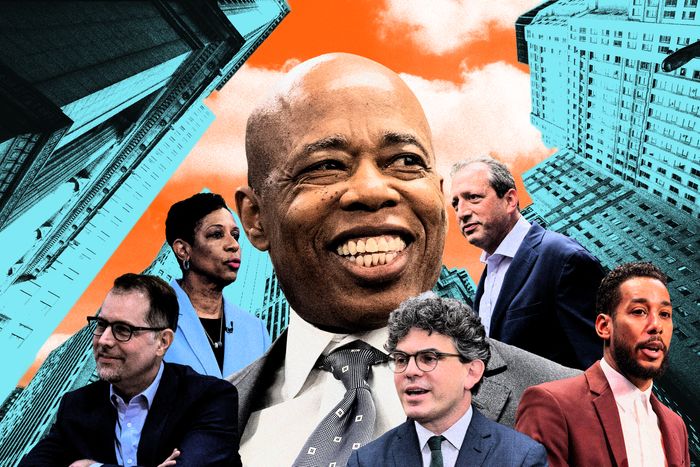What Everyone’s Saying About Those Housing Ballot Proposals – Curbed

Report on Proposed New York City Charter Amendments for Housing Development
Introduction and Executive Summary
New York City is confronting a critical affordable housing shortage, a challenge directly impacting its ability to meet several United Nations Sustainable Development Goals (SDGs), notably SDG 11 (Sustainable Cities and Communities). The existing development approval process, characterized by deference to local councilmembers, has resulted in insufficient housing construction and inequitable development across boroughs, hindering progress towards SDG 10 (Reduced Inequalities). In response, a mayoral commission has introduced three ballot proposals—Propositions 2, 3, and 4—to amend the city’s Charter. This report analyzes these proposals, stakeholder perspectives, and their potential implications for achieving sustainable and inclusive urban development in New York City.
Background: Housing Development and Governance Challenges
The current land-use approval framework in New York City presents significant barriers to the development of affordable housing, undermining the city’s commitment to key SDGs. The primary challenges include:
- Arduous Approval Process (ULURP): The lengthy and costly Urban Land Use Review Procedure (ULURP) disincentivizes all but the largest-scale projects, limiting the creation of new housing stock.
- Councilmember Deference: The practice of deferring to the local councilmember’s preference grants them veto power over projects, which can stall or block necessary housing development for political reasons.
- Uneven Development: This system has fostered an inequitable landscape where some districts accommodate new construction while others resist it, exacerbating spatial inequalities and failing to meet the principles of SDG 10. This directly conflicts with the goal of creating inclusive communities as outlined in SDG 11.
Analysis of Proposed Charter Amendments
The three ballot proposals aim to reform the city’s governance structure for land use to accelerate affordable housing construction, aligning with SDG 11.1, which calls for access to adequate, safe, and affordable housing for all.
-
Proposition 2: Expediting Affordable Housing Projects
This proposal seeks to fast-track specific types of affordable housing projects to address poverty (SDG 1) and provide housing for vulnerable populations.
- It would create a streamlined review process for publicly financed, 100 percent affordable projects, including supportive and senior housing.
- It would empower the mayor-appointed City Planning Commission to approve developments that are at least 25 percent affordable in the 12 community districts that have built the least affordable housing, directly addressing the inequitable distribution of development (SDG 10).
-
Proposition 3: Streamlining Modest-Scale Developments
This proposition targets the “missing middle” of housing by simplifying the process for smaller projects, contributing to more sustainable and dense urban forms (SDG 11).
- It would allow projects with modest increases in size or density to bypass the full ULURP process.
- This change is intended to make smaller, incremental development financially viable, diversifying the housing supply.
-
Proposition 4: Creation of an Affordable-Housing Appeals Board
This is the most contentious proposal, aiming to create a new institutional mechanism (SDG 16: Peace, Justice and Strong Institutions) to overcome local opposition to housing.
- It would establish an appeals board composed of the Mayor, the City Council Speaker, and the relevant Borough President.
- This board would have the authority to reverse City Council land-use decisions, fundamentally shifting power away from local councilmembers.
Stakeholder Perspectives and SDG Implications
The proposals have ignited a debate over the most effective governance model for achieving sustainable urban development, pitting centralized efficiency against local participatory planning.
Arguments in Opposition
Opponents, led by the City Council, argue the proposals undermine democratic processes and could worsen inequality, conflicting with the spirit of SDG 11.3 (participatory planning) and SDG 16 (inclusive institutions).
- Loss of Community Power: Councilmembers contend the changes are a “top-down” power grab that strips communities of their ability to negotiate for benefits like schools, parks, and deeper affordability.
- Risk of Unchecked Development: There is concern that the reforms could lead to a return to an era of exclusionary planning, promoting gentrification and displacement that disproportionately affects marginalized communities, thereby violating the principles of SDG 10.
- Mayoral Influence: Critics highlight that empowering the mayor-appointed City Planning Commission and a new appeals board centralizes land-use authority, reducing local accountability.
Arguments in Support
Proponents, including Mayor Eric Adams, Comptroller Brad Lander, and several Borough Presidents, argue the reforms are necessary to create more effective and accountable institutions (SDG 16) capable of addressing the housing crisis.
- Overcoming NIMBYism: Supporters believe the changes will counteract obstructionism in districts that have failed to contribute their fair share of housing, promoting a more equitable city (SDG 10).
- Accelerating Affordable Housing: The proposals are framed as essential tools to build affordable housing faster and at a lower cost, directly advancing SDG 1 (No Poverty) and SDG 11.1 (Affordable Housing).
- Strengthening Institutional Roles: The changes would restore some land-use authority to Borough Presidents, creating a more balanced governance structure that can support development without being beholden to hyper-local political pressures.
Conclusion
The proposed Charter amendments represent a significant effort to reform New York City’s land-use governance to better align with the objectives of the Sustainable Development Goals, particularly SDG 11. The core of the debate is whether these changes will create a more efficient and equitable system for housing development or if they will sacrifice the crucial principle of participatory planning. The outcome of the vote will have profound implications for the city’s ability to build inclusive, resilient, and sustainable communities for all its residents.
Analysis of Sustainable Development Goals in the Article
1. Which SDGs are addressed or connected to the issues highlighted in the article?
-
SDG 11: Sustainable Cities and Communities
The article’s central theme is the challenge of providing adequate and affordable housing in New York City. It directly addresses the need to make cities inclusive and sustainable by reforming land-use and housing development policies. The discussion revolves around building more housing, ensuring its affordability, and managing urban development in a way that serves all residents.
-
SDG 10: Reduced Inequalities
The article highlights how the current housing approval process creates an “uneven landscape” where some neighborhoods block new construction, potentially exacerbating inequality. It references historical “exclusionary planning that promoted segregation, displacement, gentrification, and environmental injustice, disproportionately of Black and Latino communities.” The proposed changes aim to distribute affordable housing development more equitably across the city, particularly in “districts that lagged the most in affordable-housing construction,” thereby addressing spatial and economic inequalities.
-
SDG 16: Peace, Justice and Strong Institutions
The article is fundamentally about governance and institutional reform. It details a proposal to amend the city’s Charter, its “governing document,” to change how land-use decisions are made. The debate between the City Council, the Mayor, and community boards over the ballot propositions is a clear example of efforts to develop more “effective, accountable and transparent institutions.” The conflict centers on ensuring “responsive, inclusive, participatory and representative decision-making” while also achieving city-wide housing goals.
2. What specific targets under those SDGs can be identified based on the article’s content?
-
Target 11.1: Ensure access for all to adequate, safe and affordable housing and basic services.
This target is the primary focus. The article explicitly discusses the “desperate need to build more affordable housing.” The ballot proposals are designed to facilitate this, with Proposition 2 aiming to speed up the review process for projects that are “100 percent affordable,” including “supportive- and senior-housing developments,” and for projects that are “at least 25 percent affordable” in underserved districts.
-
Target 11.3: Enhance inclusive and sustainable urbanization and capacity for participatory, integrated and sustainable human settlement planning and management.
The article details the struggle over New York’s urban planning process, specifically the “arduous approvals process” known as ULURP (urban land use review procedure). The proposed changes in Propositions 2, 3, and 4 are attempts to reform this “human settlement planning and management” system. The debate reflects the tension between participatory planning (represented by the local councilmembers’ power) and a more integrated, city-wide approach to address the housing shortage.
-
Target 16.7: Ensure responsive, inclusive, participatory and representative decision-making at all levels.
This target is at the heart of the political conflict described. The current system, which “defers to local councilmembers’ preferences,” is seen as a form of participatory decision-making. Opponents of the ballot measures argue the changes would “strip communities of their power” and “shut local communities out of the decision-making.” Proponents argue the reforms are necessary to overcome localized opposition (NIMBYism) that prevents the city from meeting its broader housing needs, thus making the overall decision-making process more responsive to the city-wide crisis.
3. Are there any indicators mentioned or implied in the article that can be used to measure progress towards the identified targets?
-
Number and percentage of affordable housing units built.
The article directly mentions goals for projects to be “100 percent affordable” or “at least 25 percent affordable.” A key indicator of progress towards Target 11.1 would be tracking the number of new units approved and constructed under these affordability criteria, especially following the proposed charter changes.
-
Geographic distribution of new housing developments.
The article identifies an “uneven landscape” and “12 community districts that lagged the most in affordable-housing construction.” An indicator for Target 11.3 would be measuring the number of new housing units built in these specific districts to see if the reforms lead to a more equitable distribution of development across the city.
-
Approval time for housing projects.
The article notes that the current process is “arduous” and that projects “can take more than a decade from proposal to completion.” Propositions 2 and 3 are designed to “simplify and speed up the review process.” A measurable indicator for progress would be the average time it takes for affordable housing projects to move from proposal to approval and completion, comparing data from before and after the potential charter amendments.
-
Changes in decision-making outcomes.
Proposition 4 proposes an “affordable-housing appeals board that could reverse City Council land-use decisions.” An indicator for Target 16.7 would be the number of projects appealed to this board and the number of City Council decisions that are overturned. This would directly measure the shift in institutional power and decision-making authority.
SDGs, Targets, and Indicators Analysis
| SDGs | Targets | Indicators |
|---|---|---|
| SDG 11: Sustainable Cities and Communities | 11.1: Ensure access for all to adequate, safe and affordable housing and basic services. |
|
| SDG 11: Sustainable Cities and Communities | 11.3: Enhance inclusive and sustainable urbanization and capacity for participatory, integrated and sustainable human settlement planning and management. |
|
| SDG 10: Reduced Inequalities | 10.2: Empower and promote the social, economic and political inclusion of all. |
|
| SDG 16: Peace, Justice and Strong Institutions | 16.7: Ensure responsive, inclusive, participatory and representative decision-making at all levels. |
|
Source: curbed.com
What is Your Reaction?
 Like
0
Like
0
 Dislike
0
Dislike
0
 Love
0
Love
0
 Funny
0
Funny
0
 Angry
0
Angry
0
 Sad
0
Sad
0
 Wow
0
Wow
0
















































/environment-climate-change-and-health-(ech)/water-sanitation-hygiene-and-health-(wsh)/landfill-tuvalu-36092.tmb-1200v.jpg?sfvrsn=5c21fe40_1#)

.jpg.webp?itok=0ZsAnae9#)
























